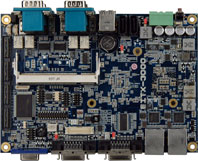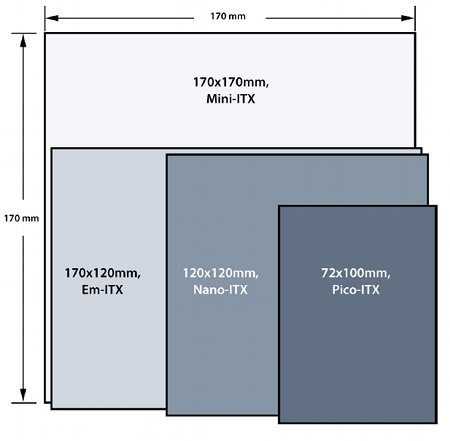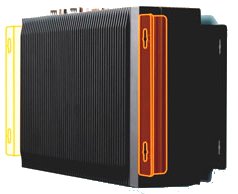Industrial computer debuts Em-ITX format
Mar 5, 2010 — by Eric Brown — from the LinuxDevices Archive — 5 viewsVia Technologies announced an embedded industrial computer based on uts Em-ITX form factor. The fanless, ruggedized ART-3000 is built around Via's EITX-3000 main board, which is equipped with a 1.3GHz Via Nano processor, and supports up to three displays and two independent video content streams, says Via.
 The Via ART-3000 is designed for a variety of kiosk, POI, digital signage, and industrial automation applications, says Via. The computer appears to be the company's first to incorporate its EITX-3000 system board (pictured at right), which was announced in late March 2009. The EITX-3000 in turn was Via's first motherboard to be based on the 170 x 120mm Em-ITX format, which was introduced earlier that month.
The Via ART-3000 is designed for a variety of kiosk, POI, digital signage, and industrial automation applications, says Via. The computer appears to be the company's first to incorporate its EITX-3000 system board (pictured at right), which was announced in late March 2009. The EITX-3000 in turn was Via's first motherboard to be based on the 170 x 120mm Em-ITX format, which was introduced earlier that month.
The EM-ITX format (see below) offers dual I/O "coastlines," plus an "Em-IO" expansion bus that supports optional add-on modules. Measuring about 6.7 x 4.7 inches, the format is the same width as Via's Mini-ITX, but with the height of Via's smaller (120x120mm) Nano-ITX format. The rectangular shape allows dual "coastlines," providing 19 percent more room for real-world connectors than if a square had been utilized, according to the company.

Em-ITX is 30 percent smaller than Mini-ITX, but has twice the coastline, Via says
(Click to enlarge)
The EITX-3000 board is based on Via's 1.0 or 1.3GHz Nano processor and VX800 media system processor. Via located the processors on the reverse side of the board to make more room for passive cooling apparatus. The ART-3000 system is equipped with the 1.3GHz version of the Nano, and offers a SODIMM socket that can handle up to 2GB of DDR2 RAM. The system also offers diskless booting, says Via.

Via ART-3000

ART-3000 ports, front and back
(Click to enlarge)
The ART-3000 is equipped with an on-board DC-DC power converter with variable power input (DC 7V ~ 36V) that is said to support both AT and ATX modes. Typical power consumption is said to be 18.5 Watts, with a 25.8 Watt maximum.

A side view of Via's ART-3000
Specifications listed for the Via ART-3000 include:
- Processor — 1.3GHz Via Nano ULV with FSB 800MHz and 1MB L2 cache on EITX-3000 mainboard
- Chipset — Via VX800 Unified Digital Media IGP with Via Chrome9 HC3 DX9 3D/2D graphics controller; supports up to 256MB frame buffer using system memory
- Memory — up to 2GB DDR2 (533/667MHz) via 1 x 200-pin SDRAM SODIMM socket
- Flash — 1 x CardBus/CF socket, type I/II
- Storage - 1 x 2.5-inch SATA HDD bay
- Display — 1 x VGA connector for 1920 x 1200; 2 x 24-bit LVDS connectors for up to 1280 x 1024; dual independent (triple concurrent) display
- Audio — Via VT1708B high definition audio codec; supports Line-out and Mic-in
- Networking — 2 x gigabit Ethernet controllers (Via VT6130)
- USB - 4 x USB 2.0 ports (2 x front-facing)
- Serial — 4 x serial COM ports (2 x front-facing)
- Other features — Watchdog timer; 2 x LEDs
- Power — DC 7V ~ 36V; built-in DC-to-DC converter; typical 18.5 W power consumption (25.8 W max.)
- Operating temperature — 68 to 140 deg. F (20 to 60 deg. C) with CF storage; 32 to 113 (0 to 45 deg. C) with HDD
- Shock resistance — 20G with HDD (50G with CF only) IEC 60068-2-27, half sine, 11ms duration
- Vibration resistance — 1Grms with HDD (5Grms with CF only) IEC 60068-2-64, random, 5 ~ 500Hz, 1 Oct./min, 1hr/axis
- Dimensions — 8.13 x 4.86 x 2.28 inches (206.5 x 123.5 x 58mm); with bracket 9.17 x 4.86 x 2.57 inches (233 x 23.5 x 65.2mm)
- Operating system — Linux (MID edition; image only); Windows XP Embedded SP3; Windows CE 6.0 Pro
Stated Daniel Wu, vice president of Via's Embedded Platform Division, Via Technologies, "Customers can now take advantage of a complete fanless, ruggedized system that offers incredible flexibility, a wide feature set, and excellent stability straight out of the box."
Availability
Via did not provide pricing or availability information on the Via ART-3000 system, but it appears to be available for order now. More information may be found here.
This article was originally published on LinuxDevices.com and has been donated to the open source community by QuinStreet Inc. Please visit LinuxToday.com for up-to-date news and articles about Linux and open source.